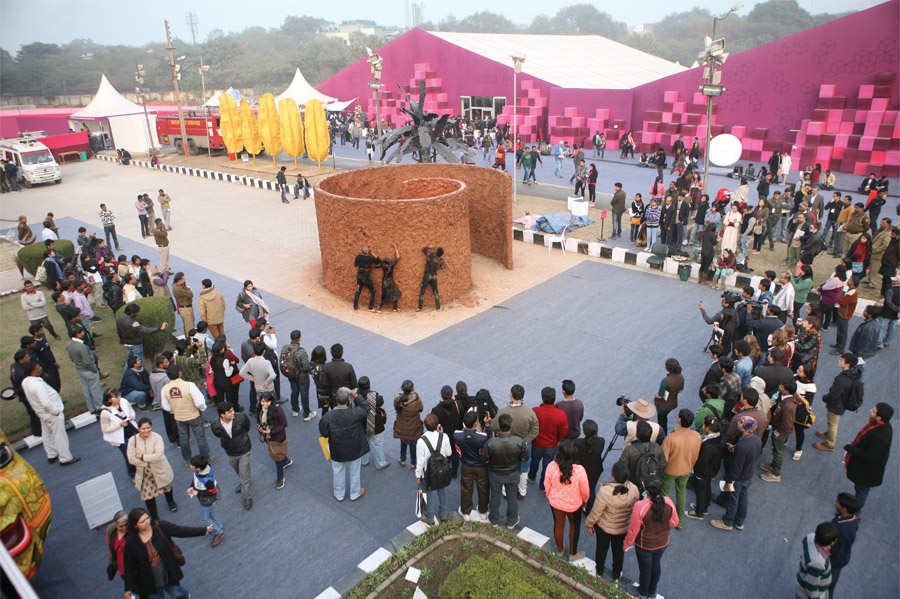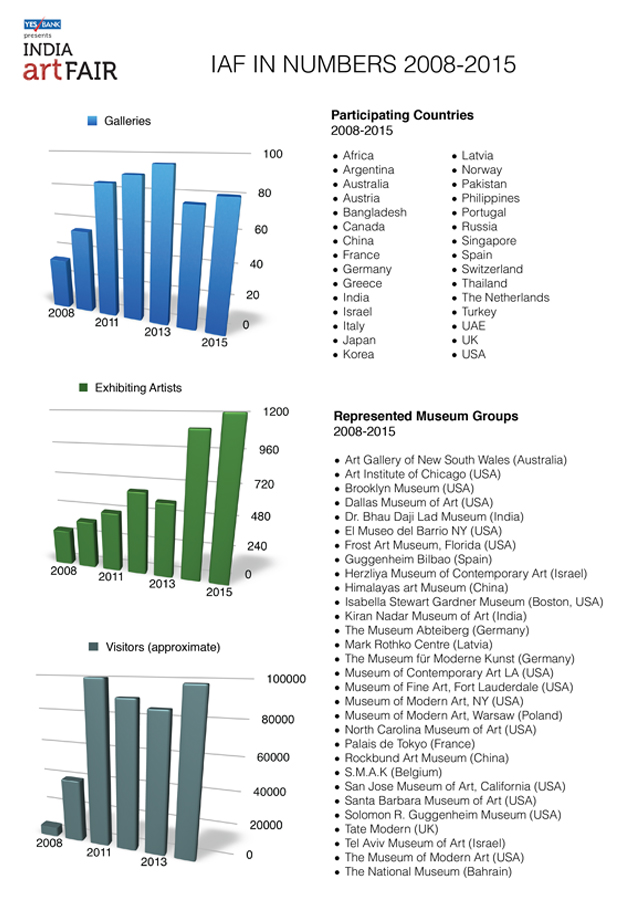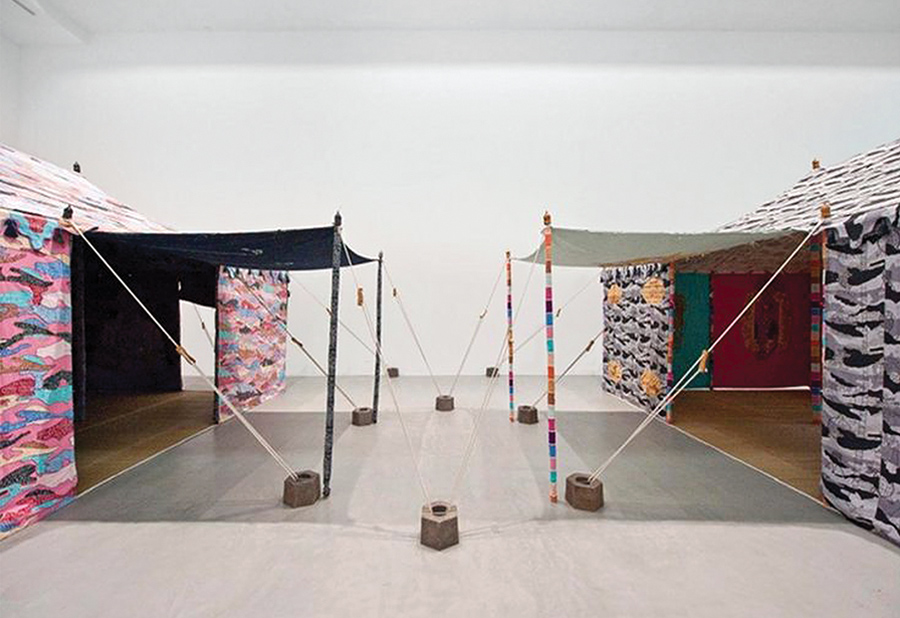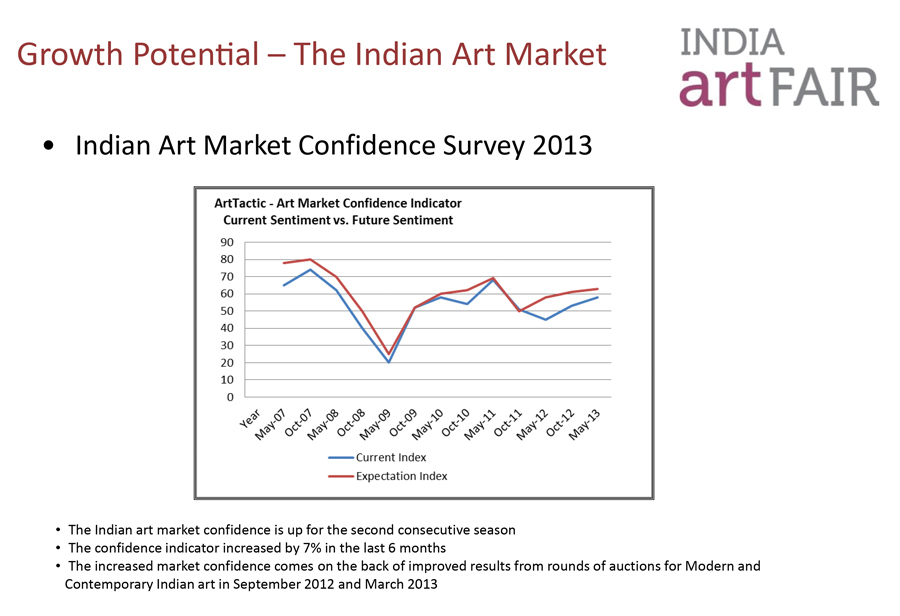At 26 years old, Neha Kirpal transformed the South Asian art scene by founding India Art Fair, a massively complex and ambitious endeavour just gearing up for its seventh edition. Over tea at the Fair’s Kailash Colony office, the disarmingly cheerful executive describes how the focus of the fair has evolved over the years, and how the collecting base it established has matured along with it.
Sophia Powers (SP): What would you like people to understand about what goes on behind the scene at art fairs?
Neha Kirpal (NK): Well, people tend to look at all art fairs as one type of entity, whereas there’s no such thing. There’s no one model of art fairs globally, and every fair has to define itself by its own region and its own local context, and in a sense what it’s trying to achieve. So there are certain fairs that are purely about being commercial transacting fairs, and not really about building a market. They’re not even based in a local market, so it’s a destination fair.
If you look at all the Basels, for instance, they’re not trying to educate people and build a market; they’re about pure business, which is completely different from India, say, where we’re building a local market. It’s a local, city-based fair. It’s not a destination fair, in that it’s focused on Indian art, Indian markets, and what we’re kind of building from the ground up. And then there are similar local fairs, but in a very different, very developed art context, like Frieze in London. That’s also very much a city fair, in that it’s primarily focused on the UK audiences and, of course, with audiences from around the world, but there is a local focus, both in terms of the art as well as in terms of the buyer. But it’s very different from India because it’s in a very involved art market. We’re many, many stages behind in terms of how we’re looking at contemporary art and especially international contemporary art. And so in that sense you can’t just say art fairs in one breath and compare them all in an equal kind of measure. The objectives of each one vary, and so how they can be measured is different.
What’s also interesting is the promoters of different art fairs around the world. If we see over the last few years, there have been major companies that have held more than one art fair around the world. And it’s becoming, in a way, a global monopoly. So, for example, Basel has been going for 44 years or 45 in Switzerland, and now they’ve got Hong Kong and Miami, and they’ve sort of covered the world in terms of the top end, commercial, business transacting.
And then you’ve got local fairs that are serving a completely different demographic. Their strengths will always be their local markets, which will never be Basel’s strength, because it’s not intended to be. But they will stand out in their own ways. Take my business partners, for instance. Between them, they have about 30 art fairs around the world. Some at the affordable segment, some at a high-end segment – Istanbul, Hong Kong, Shanghai, Delhi. Some of these organizations, like the company that runs the Basels, runs several trade shows, and art is just one of their trade shows, and in a way, it’s the most visible, it’s the most brand-building exercise for them, and so they spend a lot of money. I guess that’s also an interesting fact about art fairs – they’re very, very expensive to do. No matter where you do them, it’s a very expensive business, with returns that are very marginal, because the idea is to build a brand, or build a country’s art scene, or basically to spend money and woo clients for your primary market galleries. So motives are different for different art fair organizers, I think.

It’s very much about their individual contexts, and I think that is something that is seldom recognized. People just blanket compare a Basel with a Frieze, with India. I guess what’s also interesting is that it’s changing from a collector’s point of view. No longer is it interesting for collectors to follow White Cube or follow Gagosian all over the world. They just go to their galleries and go to some of the fairs. Whereas when they go to Dubai they want to see Middle Eastern art, when they come to India they want to see art from India and the region. When they go to Istanbul, they want to see art from that region. There are also people looking for differences, and that’s kind of where the opportunity of our emerging markets comes up.
SP: Do you see particular kinds of galleries choosing to show at the India Art Fair for specific reasons?
NK: Right from the day we started, the focus was on India and the region – which was the immediate subcontinental region. The idea was to keep at least 50 percent of the fair local, and from the region, and 50 percent from the rest of the world. And with that, what we would do is have both sets of offerings. The art fair gives a really easy-to-negotiate, easy-to-enter window into India. It gives it that organized structure and world-class format to tap into India, and some galleries do it as an experiment. Some galleries do it simply because they love India, and they like to do business here.
Some do it for the real future business potential, but what we see with most people is the desire for a long-term relationship. Because it takes time when you’re building a market when you’re showing international art to people who have never seen it before when there are very few museums and very few galleries that show international art year-round. It’s an educational process, and it will take time. So people who are in it for the long term tend to do a lot better.
Galleries that are in it in a way where they have some connection with India tend to do better. So, for example, in their booth program, if they have even one Indian artist, and then they have a whole international set of artists, people will become familiar with their booth and then they can share their international program with them as well. It’s a small sort of conversion process. And so galleries come in to tap the future of the Indian art market, in the present. And some alternate between various emerging markets. They’ll do Rio one year, they’ll do India one year, so there’s a bit of that going on. (1)
Also, people come in to pick up on the art scene here. So it could be to do exchange shows, to represent Indian artists abroad. We’ve seen since the art fair started, there’s a huge increase in the number of Indian artists who are doing shows with international galleries. I think for the Indian galleries what’s interesting is that by creating an art fair here, for that time in January we bring the art world’s attention.
For example, if you have Indian galleries that go and participate, let’s say in FIAC, they may not get the attention from Western collectors and French collectors as much as they would get it from them if they came to India. Because here, India is the focus, and they know that if big museums are coming to India, they’re coming to look at Indian art. Otherwise, they’re going to remain one percent of the local art market. How do you change that? It’s very cost prohibitive, and very expensive and difficult for Indian galleries to change that by going abroad and doing things. With the complete lack of
state support, no participation in international biennales, and no country pavilions, how are people going to know about Indian art? The only real sustainable way is to do it on our turf here. So I think that’s the real value creation for the Indian galleries, and that’s why they keep coming back here.

SP: I had read in previous interviews that increasing accessibility was a major impetus for starting the fair. So how do you think about your audience now? I know the fair began on the grounds of Pragati Maidan but has now shifted (to the NSIC exhibition ground). How do you balance wanting it to be accessible with wanting to provide an elite experience for VIPs that come from all around the world and expect a certain level of exclusivity?
NK: That’s always the challenge, and it’s important to remember and define priorities, and what you do about each. I think in past years, the focus was certainly more towards broadening the base of people who come to the art fair because what we do through that is broaden the base of the art market altogether. In the last two years– this year particularly, our focus has been on strategically looking at building the top end of the market.
So, in a way, we’ve sort of turned it on its head. Our first focus was on ushering in the culture of actually seeing art. It didn’t matter what kind of art, it didn’t matter if you bought or not, just come and engage. But having achieved that milestone now, our focus has shifted towards strategically looking at bringing in and building communities within the collecting audience – both at an international level with non-Indians and international audiences and also at the local level.
So we’ve done a few very focused initiatives specifically for that. We have a strong museum outreach program between me and my business partners, since they ran the Hong Kong art fair, so there have been a wide range of museums that have been coming to the fair. Last year, we had about 26 museums participate. (2) We’re also working consciously with corporates. We see the very limited patronage of corporate patrons of the arts. In terms of sponsorship for art events, in terms of buying in corporate collections – it’s almost nonexistent.
So we’ve been engaging at the promoter level, and then at the top management level, to bring in a degree of not just interest, but real commitment. We’re also looking at putting together a sort of arts council. A patron’s council, if you like, would bring together a set of key industrialists and corporate entrepreneurs who are in a position of influence and poised to make substantial financial contributions and commitments to art. So that’s a very structured exercise that’s going on at the moment. And what’s important with that is to do it pan-India, and not just have a Delhi and Bombay focus. So we’re very consciously looking at developing the market in Ahmedabad, Surat, Chandigarh, Trivandrum and Hyderabad, a whole range of cities, so the plan broadly spans 20 cities, rather than two, to be able to create a degree of engagement. It is also to recognize that in those cities, there are people who have the interest and have the money and are big collectors of today and tomorrow.
We’re doing more in terms of collector engagement at the fair and around the fair, in terms of social events. We always had a VIP program, but we’re making it that much more substantial. We’re making specific efforts to encourage collectors to come back a second time to the fair. We’ve also brought an artistic director on board this year, Girish Shahane and the idea of bringing him on is to create a degree of freshness and energy. We’ve felt that over the last few years the quality of the art fair – in terms of the art itself – some people have felt it was slightly stagnating and it could do with a boost of energy and freshness. And so there are works this year in the curated projects section that are very challenging and space-specific. Some of them are live performance-based, including collaborative work. These are all very subtle, but very conscious ways in which we want to focus on the top end of the fair.

We’ve also seen a great response from important museum delegations. We’ve seen museums come back. They would come previously with a few patrons each. This year we have two or three groups with more than 25, 28, and 30 patrons each, so we’ve realized it would really take off. We did an assessment of all the art fairs, actually, with Frieze, with Basel, with everyone, and found that the international, total, collecting base with all the art fairs put together is less than 8,000 people. That’s prospective. So actually, literally, you’re going after them one by one. As much as we may say it’s a very small collecting base in India, it’s growing. And you know it will grow more and more.
SP: I read that you had the idea for the art fair in London — that you scribbled it
in an airplane on the back of a puke bag! Did you crunch numbers before you realized that the fair was going to be such a success?
NK: I don’t think that data really existed, and if I had to crunch numbers, I wouldn’t have done it. Because the numbers, at that stage, were just terrible. And other people who knew their numbers a lot better than me clearly told me – it’s a bad idea. Forget about it. So I don’t think it was at all from a business-aware point of view. I don’t have a business background, and I don’t think I was really thinking straight. And that’s great. Because that’s really why I was able to say, okay, I’m 26 years old, I’m just going to do it. It was a bit of that sort of blissful ignorance. I guess when you’re not an insider, you’re not aware as much of the realities and the problems. And so the hard part was not coming up with the idea, because it’s not really an idea – it’s obvious. I mean it’s happening all over the world, but I was looking around and saying, “Why doesn’t India have an art fair?” So the harder part was not really what was on the puke bag, it was actually doing it. But what I found was that, although it was difficult – it was difficult for reasons of funding, for reasons of the lack of infrastructure in India to show something at this standard – it showed us what the exhibition standard in this country is, and how terrible it is, effectively, in terms of what’s needed for showing art. So that was all hard, but what we also realized was that were are a lot of people – just enough, obviously – who wanted to get behind something like this, who wanted success, who saw the relevance of a platform like this. I think some people got behind it because they could really see that this would make a market for the arts and for industry around art – not just for buying and selling, but also for art publications and art shippers and framers and restorers, and art merchandise, and art insurers. And people saw that India had lost its place on the international art scene and that maybe this is some way of finding our own place.

People recognized that the government would not help, so if it has to be a private venture, then what better than someone who is new and is not from the art world? I think if it was someone from the art world, it would have been harder, because there is a degree of mistrust, and sort of baggage I suppose, and so for all of those reasons, people got behind this. And a lot of people supported it simply because they were like, “Wow, here is this young woman and she’s trying to do this.” So whatever their reasons might have been, I think a lot of people really stood with the art fair and helped it get direction, get focus, get participation, believed in what it could be, and believed that we would deliver it with a certain degree of integrity and quality and that’s really what made it.
SP: I’m curious how you think Kochi changed the art fair or influenced the art
fair?
NK: It’s great that it’s happening because, before Kochi, the only thing that India was known for was the India Art Fair. And now there are two very different, very interesting platforms that, in a way, define the Indian art scene – both for local and international audiences. We’re two mutually complementing initiatives that are much needed, and I think people awaited a biennale as much if not more than they’ve waited for an art fair. So it’s really overdue, and it’s really great that it’s happening.
I feel like the more people can see us in complementary roles, the better it would be for them to really be inspired and excited about what India overall can offer. And at the end of the day, it’s about sustainability. The question for an art fair is not whether it’s set up – there are lots of fairs being set up. There is a huge proliferation of fairs around the world. The question is, how many of them will survive, and have survived over time? There are an equal number of fairs shutting down. That’s not such a widely reported fact. But the point is sustainability. I think the answer to that is you can only sustain yourself if you are in a market that can sustain and has long years ahead. And in that sense, I feel privileged that we have been doing this in India.
1. See graphics for participating countries and gallery attendance figures from 2008 – 2015.
2. See graphics for a full list of museum groups represented at India Art Fair.
Images courtesy: India Art Fair













